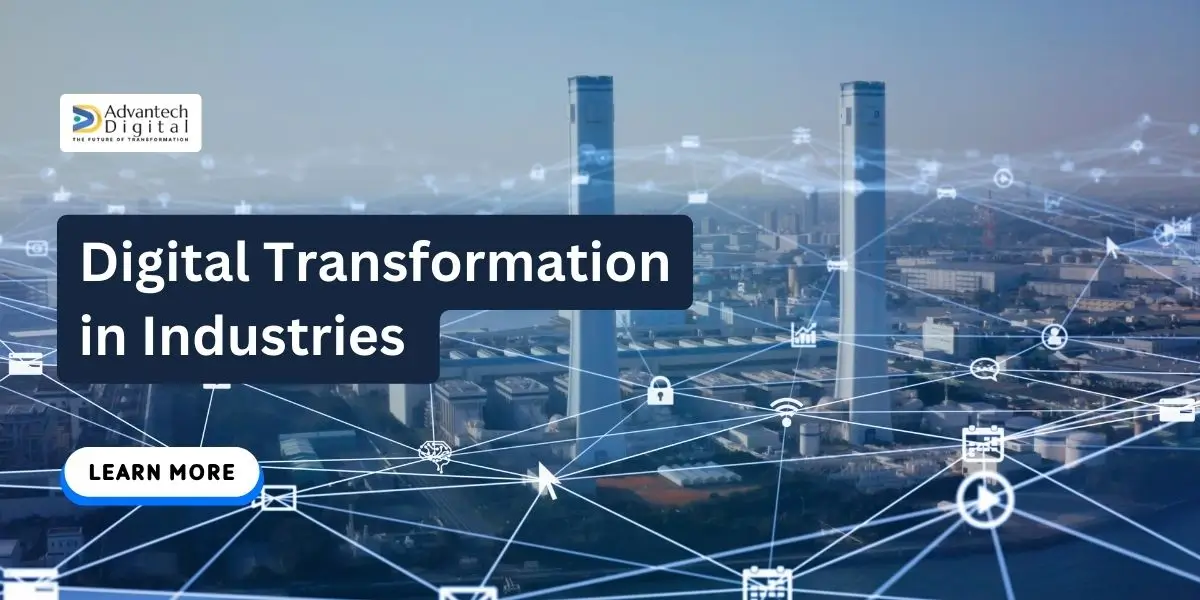The digital transformation importance for business success is undeniable in today’s digital-first economy. A staggering 71% of surveyed businesses attribute increased revenue to digital transformation. This revolution isn’t a matter of if, but when and how to embrace it.
Technological advancements and evolving consumer expectations drive companies to adapt and innovate. Emerging technologies like AI, IoT, and cloud computing are reshaping industries. Success requires more than new tools; it demands a fundamental shift in organizational culture.
At Advantech Digital, we navigate this complex digital landscape with expertise. We develop strategic roadmaps, integrate cutting-edge technologies, and foster innovation. Our experts collaborate closely with clients to identify opportunities and streamline processes.
The path to digital transformation is challenging. A BCG study reveals that 75% of transformations fail to meet their goals. This underscores the need for a well-planned, holistic approach.
Successful transformation considers people, processes, and technologies. It requires experimentation, learning from failures, and continuous iteration based on data-driven insights.
Key Takeaways
- Digital transformation is crucial for business success in 2025’s digital-first economy
- Embracing emerging technologies and fostering a culture of innovation are key
- 71% of businesses attribute increased revenue to digital transformation
- Navigating the digital landscape requires a strategic, holistic approach
- Partnering with experts like Advantech Digital can help businesses unlock new opportunities
The Evolving Landscape of Digital Transformation
Staying ahead in business requires constant adaptation. The tech industry evolves rapidly, demanding ongoing research and execution. Several key digital transformation trends are shaping the business landscape for 2024-2025.
Continuous Innovation and Adaptation
Thriving in the digital age requires embracing continuous innovation. Companies must proactively monitor market changes and anticipate customer needs. This approach allows businesses to quickly adjust their digital strategies and seize new opportunities.
Recent studies show digital technology can boost efficiency by 25%. It also improves customer satisfaction. Enhanced collaboration increases productivity, while chatbots and CRM systems boost customer loyalty and retention.
Staying Ahead of the Curve
Several key digital transformation trends will revolutionize business by 2025. These include tech-driven sustainability initiatives and integrated AI solutions. The rise of Everything as a Service (XaaS) models offers flexibility and scalability.
Multi-layered cybersecurity strategies will protect against evolving threats. Businesses must monitor these trends and incorporate them into their digital strategies. This approach enhances agility and enables quick responses to market changes.
“Digital transformation is not just about technology; it’s about fundamentally rethinking how we do business in the digital age.”
Embracing change and innovation is crucial for success in digital transformation. Staying attuned to trends and fostering adaptability unlocks new growth opportunities. This approach helps businesses thrive in the coming years.
Tech-Driven Business Sustainability
Companies are realizing sustainability’s role in long-term success. Innovative technologies and eco-friendly initiatives can reduce environmental impact and boost profitability. These efforts also enhance organizations’ overall ESG scores.
Lowering Environmental Impact and Increasing Profitability
Digital technologies optimize operations and reduce carbon footprints. Data analytics and IoT devices provide real-time insights for cleaner operations in energy companies. Energy-efficient and green technology investments align digital transformation with sustainability goals.
These initiatives ultimately reduce energy consumption and costs. Organizations can achieve both environmental and financial benefits through tech-driven sustainability efforts.
Governmental Policies and Investor Trends
Governments and investors prioritize sustainability, rewarding eco-friendly companies. The global energy transition aims to reduce greenhouse gas emissions through renewable sources. Solar, wind, and hydroelectric power adoption is increasing worldwide.
The U.S. Energy Information Administration’s report shows a clear shift towards renewables. This change is driven by supportive policies and investor demands.
Engaging Employees in Eco-Friendly Initiatives
Creating a sustainable culture requires active employee engagement. Recycling programs, digital literacy promotion, and eco-friendly practices empower the workforce. Blockchain technology can enhance supply chain transparency and ensure responsible environmental practices.
Companies must recognize the link between technology and sustainability. Innovative solutions and employee engagement reduce environmental impact. These efforts boost competitiveness in a sustainability-focused market.
Integrated Generative and Analytical AI
In 2025, the fusion of generative and analytical AI is revolutionizing businesses. This blend of creative power and data-driven insights unlocks unprecedented innovation and efficiency. Organizations are reaching new heights by combining these complementary technologies.
Generative AI, like GPT-4, is transforming content creation and problem-solving. It empowers businesses to push creative boundaries in marketing and product design. Analytical AI excels at processing vast data amounts, uncovering valuable insights for strategic decisions.
By 2025, Gartner predicts 75% of enterprises will fully operationalize AI. This shift towards enterprise-wide adoption is expected to yield significant benefits. These include increased productivity, cost savings, and supply chain optimization.
- McKinsey reports AI-driven automation could raise global productivity growth by 0.8 to 1.4 percent annually.
- Accenture estimates AI in healthcare could save the U.S. economy up to $150 billion annually by 2026.
- McKinsey estimates AI-driven supply chain management could unlock $1.2 trillion in value annually.
The impact of integrated AI is evident across various sectors:
| Industry | Generative AI Application | Impact |
|---|---|---|
| Healthcare | Generating diagnostic reports and personalized treatment plans | Improved patient outcomes |
| Finance | Enhancing fraud detection and providing personalized banking experiences | Increased security and customer satisfaction |
| Retail | Efficient inventory management and personalized shopping experiences | Reduced response times and boosted customer satisfaction |
A notable retail success story involved integrating Generative AI into customer service operations, notably reducing response times and boosting customer satisfaction.
Businesses are transforming operations and redefining work by harnessing integrated AI power. Intelligent automation frees employees to focus on higher-value activities requiring human creativity. This synergy between human and machine intelligence drives innovation in the digital age.
The Power of Everything as a Service (XaaS)
The concept of “Everything as a Service” (XaaS) is revolutionizing digital transformation. XaaS provides subscription-based models for AI, cloud management, digital platforms, blockchain, and automation. It enables businesses to access cutting-edge technology without hefty infrastructure investments.
XaaS services are gaining popularity rapidly. Gartner predicts IT spending will exceed $1.3 trillion in 2022 and reach $1.8 trillion by 2025. This growth is primarily driven by investments in cloud technologies like XaaS.
The public sector is also embracing this trend. In 2022, 54% of government CIOs plan to increase funding for cloud platforms. Conversely, 35% intend to reduce investments in legacy infrastructure and data centers.
Benefits of the XaaS Model
XaaS offers significant advantages to organizations aiming to stay competitive in the digital age. By using as-a-service solutions, businesses can substantially reduce infrastructure costs. They also gain scaling flexibility and access to the latest technologies without constant upgrades.
This model allows companies to concentrate on their core competencies. Meanwhile, service providers handle the technical complexities, freeing up resources for strategic initiatives.
| Benefit | Description |
|---|---|
| Cost Savings | Reduced infrastructure costs and shift from capex to opex |
| Scalability | Ability to scale up or down as needed, without disruptions |
| Access to Latest Technology | Automated upgrades to cutting-edge solutions |
| Focus on Core Competencies | Outsourcing technical complexities to service providers |
Adapting to the XaaS Landscape
To maximize XaaS potential, businesses must adjust their strategies and operations. This involves evaluating current offerings for service transformation opportunities. Developing subscription-based pricing models and investing in customer success initiatives are also crucial.
XaaS continues to expand with new services like MDaaS, AIaaS, BaaS, and DBaaS. Organizations must stay agile and open to embracing these innovative solutions to remain competitive.
XaaS is not simply consumption-based computing that delivers a cloud-billing model for the use of infrastructure. It is a digital services platform that delivers a unified cloud operating model to the business and IT.
Adopting XaaS requires a strong focus on data security and privacy. Organizations must prioritize data loss prevention and robust encryption. Aligning vendor protocols with in-house standards ensures business resilience and continuity in this dynamic environment.
Multi-Layered Cybersecurity: A Strategic Imperative
Cyber threats are becoming more sophisticated and prevalent in today’s digital landscape. A multi-layered approach to cybersecurity is now a necessity, not a luxury. Organizations must safeguard critical assets and maintain business continuity.
Implementing a comprehensive, multi-layered cybersecurity strategy is crucial. As digital transformation expands, potential entry points for cyber attackers multiply. This makes a robust defense even more important.
A multi-layered cybersecurity approach is also known as ‘defense in depth.’ It involves deploying various security controls across multiple layers of IT infrastructure. This strategy assumes no single defense mechanism is foolproof.
Effective future-proofing requires multiple layers of defense. Different security controls address each type of cyber threat. This ensures comprehensive threat coverage across the organization.
AI-Powered Security Solutions
Artificial Intelligence (AI) is revolutionizing cybersecurity. It enables organizations to detect and respond to threats with unparalleled speed and accuracy. AI-powered solutions use machine learning algorithms to analyze vast amounts of data.
These systems identify anomalies and detect potential threats in real-time. By automating threat detection and response, AI enhances an organization’s defense capabilities. It’s particularly effective against sophisticated attacks, including those targeting IoT devices.
Employee Training and Awareness
The human element remains critical in maintaining robust cybersecurity. Regular security awareness training for employees is crucial. This ensures they understand cyber threats and know how to respond appropriately.
Fostering a culture of cybersecurity awareness is vital. It can significantly reduce the risk of human error, often a leading cause of security breaches.
Zero-Trust Architecture and Cloud Security
As organizations migrate to the cloud, implementing zero-trust architecture becomes paramount. Zero-trust operates on the principle of “never trust, always verify.” It assumes no user or system should be trusted by default.
This approach enforces strict access controls. It continuously validates user identities and device integrity. Zero-trust architecture minimizes the risk of unauthorized access and data breaches in cloud environments.
| Cybersecurity Layer | Key Components |
|---|---|
| Perimeter Security | Firewalls, intrusion detection and prevention systems, network access controls |
| Identity and Access Management | Strong user authentication, access controls, user provisioning |
| Data Security | Encryption, data masking, access controls, data backup and recovery |
| Application Security | Secure coding practices, web application firewalls, regular security testing |
| Endpoint Security | Antivirus software, anti-malware solutions, device encryption |
| Security Monitoring and Incident Response | Security information and event management (SIEM) systems, log analysis, incident response plans |
A multi-layered cybersecurity approach is essential in today’s hyper-connected business world. The potential cost of a data breach or significant downtime can exceed any initial investment. A proactive, multi-faceted approach builds resilience against evolving cyber threats.
This strategy ensures the continuity of an organization’s digital transformation journey. It protects against a wide range of potential security risks and vulnerabilities.
The Rising Tide of Automation
Digital transformation is reshaping our world, with automation at its forefront. The global market for hyper-automation-enabling technology is set to reach $596.6 billion by 2022. This surge highlights automation tools’ crucial role in boosting business growth and efficiency.
Cloud computing, low-code/no-code tools, and intelligent AI are revolutionizing organizational scalability. These automation tools streamline operations and optimize resource allocation. The average number of content systems in use has grown by nearly 30% over five years.
Despite progress in automating document-intensive processes, challenges persist. Organizations struggle to manage growing information volumes and complexity. A whopping 54% of critical business content remains outside content management systems.
AI microservices offer a solution to these challenges. These discrete, autonomous services accelerate innovation and market entry. By breaking down complex applications, organizations achieve greater automation and IT flexibility.
| Automation Trend | Impact |
|---|---|
| Hyper-automation | Streamlines operations and reduces manual intervention |
| AI Microservices | Facilitates innovation and accelerates time to market |
| Cloud Computing | Enables scalability and flexibility in IT operations |
Investing in workforce upskilling is crucial as automation advances. Nearly half of workers report that their employers have reduced upskilling opportunities during the pandemic. Equipping teams with automation skills fosters innovation and boosts productivity.
Harnessing the Potential of Predictive Analytics
Businesses are leveraging predictive analytics for a competitive edge. This advanced analytics subset uses statistical techniques and machine learning to forecast future events and identify risks and opportunities.
The global predictive analytics market is booming. It’s projected to grow at a CAGR of 20.4% from 2022 to 2028. The market could reach USD 38,038.83 million, driven by data-driven strategies across various industries.
Identifying Risks and Opportunities
Predictive analytics uncovers hidden patterns in vast data sets. By analyzing historical data and current trends, businesses can anticipate potential risks and opportunities. This enables proactive decision-making across various sectors.
Healthcare organizations can forecast patient admission rates using local health trends and seasonal illnesses. Retail executives can optimize inventory levels and marketing strategies by assessing historical sales data.
“Data is the new oil, and predictive analytics is the refinery that turns it into valuable insights.” – John Doe, CEO of XYZ Analytics
Optimizing Business Processes
Predictive analytics optimizes business processes by analyzing real-time operational data. Companies can identify bottlenecks, eliminate inefficiencies, and boost overall productivity. This leads to improved decision-making and targeted interventions.
In manufacturing, diagnostic analytics can pinpoint causes of production output drops. It analyzes machine efficiency, employee productivity, and supply chain logistics to provide valuable insights.
| Industry | Predictive Analytics Use Case | Benefit |
|---|---|---|
| Healthcare | Patient admission forecasting | Optimized resource allocation |
| Retail | Sales and inventory analysis | Improved profitability |
| Manufacturing | Production output optimization | Increased efficiency |
| Finance | Regulatory compliance | Reduced risk and penalties |
Predictive analytics insights enhance prescriptive analytics, which recommends optimal actions based on predicted outcomes. Combining these techniques allows businesses to anticipate events and optimize decision-making processes.
As digital transformation reshapes business, predictive analytics grows in importance. Organizations can gain a competitive edge, mitigate risks, and drive sustainable growth by harnessing data and advanced analytics techniques.
The Internet of Things (IoT) Revolution
The Internet of Things (IoT) is reshaping business operations. It allows companies to collect data and enhance processes like never before. By using IoT devices, businesses can gain valuable data-driven insights for improved efficiency and competitiveness.
Supply chain optimization is a key area impacted by IoT. Smart tracking systems monitor product location and condition during transit. This reduces waste and ensures timely delivery. Analyzing data from these devices helps identify improvements and create innovative services.
IoT’s growth is staggering, with over 7 billion connected devices currently in use. Projections show this number rising to 22 billion by 2025. This rapid expansion underscores IoT’s crucial role in digital transformation.
| Year | Number of Connected IoT Devices |
|---|---|
| 2020 | 10 billion |
| 2025 | 22 billion |
IoT adoption benefits span various industries and applications. Smart cities, sustainable buildings, telemedicine, and warehouse management are just a few examples. IoT technologies redefine how businesses interact with the digital world.
Companies can make better decisions, boost productivity, and cut costs by leveraging IoT data. The potential for improvement is vast and continually expanding.
“IoT technology can save companies money by using resources better and reducing downtime.” – Industry Expert
IoT’s convergence with AI and 5G networks will enhance connected device capabilities. The Internet of Behavior (IoB) and Internet of Healthcare Things (IoHT) showcase IoT’s expanding scope.
These advancements help understand human behavior and revolutionize healthcare delivery. IoT’s potential to transform industries is immense and growing rapidly.
Embracing IoT is crucial for businesses aiming to thrive in the digital age. Harnessing connected devices and data-driven insights unlocks new opportunities. It enhances customer experiences and drives sustainable growth in today’s competitive landscape.
Digital Transformation Importance in Driving Business Growth
Digital transformation is crucial for businesses to thrive in today’s fast-paced landscape. It unlocks new opportunities and enhances customer experience, setting companies apart from competitors. By leveraging cutting-edge technologies, organizations can drive revenue growth and secure their future.
Unlocking New Revenue Opportunities
Digital transformation unveils untapped revenue streams through data analytics and artificial intelligence. These tools provide insights into customer preferences and behavior. Companies can develop tailored products and marketing campaigns that resonate with target audiences.
Automation and cloud computing reduce operational costs significantly. This allows businesses to allocate resources towards growth initiatives. Successful organizations invest more in transforming their business rather than maintaining operations.
Enhancing Customer Experiences
Customer experience is paramount in the digital age. By 2025, businesses excelling in seamless, personalized experiences will have a competitive edge. Digital transformation enables companies to meet and exceed customer expectations through personalization and omnichannel strategies.
AI-powered solutions offer hyper-personalized interactions at scale. This ensures each customer feels valued and understood. Omnichannel strategies provide consistent brand experiences across various touchpoints, fostering higher engagement and trust.
“Only 8% of global companies achieve their targeted business outcomes from their digital transformation investment.”
Organizations must embrace a culture of experimentation and innovation to benefit from digital transformation. Integrating new technologies like AI and IoT fosters continuous improvement. This mindset enables businesses to stay ahead in the ever-evolving digital landscape.
Navigating Economic Uncertainty with Digital Resilience
Economic uncertainty looms large as we approach 2025. Over 50% of C-Suite leaders worry about its impact on revenue, risk, and profit. Developing strategies to build digital resilience is crucial for business survival.
Digital resilience hinges on agile practices. Tetra Pak’s flexible technology talent markets exemplify quick adaptation to changing skill requirements. Southern California Edison’s strategic automation processes showcase effective agile implementation.
Developing Agile Practices
Agile practices extend beyond technology to decision-making. Economic uncertainty has extended buying cycles by three months on average. Businesses must find ways to expedite decisions in 2024 and beyond.
Proactive, tailored solutions, expertise, and foresight can combat economic uncertainties. These elements drive growth and foster resilience in challenging times.
Leveraging AI for Predictive Capabilities
AI-driven predictive capabilities are vital for digital resilience. Data analytics enable personalized marketing strategies, maintaining customer loyalty during economic downturns. Reallocating funds to digital marketing channels can yield higher returns than traditional advertising methods.
Embracing digital resilience and agile practices is essential for business survival. AI and predictive analytics empower informed decisions and process optimization. These tools build a strong foundation for long-term success amid economic uncertainty.
Fostering a Culture of Innovation and Adaptability
Businesses must cultivate innovation and embrace adaptability to thrive in today’s digital landscape. Prioritizing continuous learning and effective change management positions companies for long-term success. This approach is crucial in the face of digital transformation.
Organizations like Electrolux Professional have reaped benefits from promoting intrapreneurship among employees. They foster experimentation and creativity, giving them a competitive edge. Encouraging transparency about innovation goals and strategies can enhance employee alignment and motivation.
Creating an environment that supports innovation is vital. Novartis organized a “Pitchfest” event prioritizing psychological safety. This allowed employees to share bold ideas without fear of judgment. Breaking down organizational silos can facilitate growth.
Companies must recognize the link between digital transformation and innovation to drive change. Leveraging technologies like AI, machine learning, and IoT helps businesses stay ahead. Collaborating with external partners can provide access to new ideas and expertise.
Engaging employees through innovation programs promotes participation and fosters continuous learning. Investing in training on emerging technologies enhances workforce skills and adaptability. This approach is crucial for staying competitive.
Businesses prioritizing innovation, adaptability, and learning are best positioned to navigate digital age challenges. These qualities drive sustainable growth and success in the years ahead. Embracing change is key to thriving in the modern business landscape.
Conclusion
Digital transformation is crucial for business growth as we near 2025. Companies can unlock opportunities by embracing AI, IoT, sustainability, and cybersecurity trends. The market for digital transformation is set to reach $1.275 trillion by 2026, growing at 19.1% CAGR.
Businesses that complete digital transformations see increased profits 80% of the time. They also experience market share growth in 85% of cases. Digital leaders enjoy 23% higher revenue growth than competitors, highlighting the competitive edge gained.
McKinsey’s 4D’s framework helps businesses create digital goals and redesign capabilities. It also activates ecosystems for rapid delivery and reduces financial risks. This approach enables companies to navigate the digital landscape effectively.
Digital transformation offers increased efficiency through automation and data-driven decision-making. It also improves customer experiences and scalability using digital technologies. Dominos Pizza’s successful mobile app and “Pizza Tracker” demonstrate the potential across industries.
Moving forward, fostering innovation and adaptability is key to navigating future challenges. This approach helps businesses stay competitive in the digital transformation importance era. Ultimately, it leads to sustainable success and continued growth.
FAQ
What is the importance of digital transformation for business growth in 2025?
Digital transformation is vital for businesses to thrive in today’s digital-first economy. Companies must adapt to the evolving landscape by embracing innovative technologies. Fostering a culture of innovation and developing digital skills are crucial for success. These changes unlock new opportunities and drive growth in an increasingly competitive market.
How can businesses stay ahead of the curve in the evolving digital transformation landscape?
Businesses must adopt a cycle of continuous research, adaptation, and execution to stay ahead. Key trends for 2024-2025 include tech-driven sustainability, integrated AI, and Everything as a Service (XaaS). Multi-layered cybersecurity is also crucial. Understanding and integrating these trends is essential for remaining competitive.
What are the benefits of tech-driven sustainability for modern businesses?
Tech-driven sustainability offers lower environmental impact, increased profitability, and enhanced shareholder value. Governmental policies and investor trends reward companies prioritizing sustainability. Consumers support eco-friendly brands. Engaging employees in sustainability initiatives and leveraging blockchain can further advance these efforts.
How can businesses integrate AI into their digital transformation strategies?
The frontier of AI integration lies in moving from isolated projects to enterprise-wide adoption. Generative AI creates new content and solutions. Analytical AI processes data for insights. Intelligent automation streamlines tasks and processes. Fully integrated AI across business operations can bring exponential benefits in value.
What is the “Everything as a Service” (XaaS) model, and how can businesses adapt to it?
XaaS offers AI, cloud management, digital platforms, blockchain, and automation as service-based offerings. Benefits include decreased infrastructure costs, scaling flexibility, and access to cutting-edge technology. To adapt, businesses should assess current offerings for service transformation opportunities. Developing subscription-based pricing and investing in customer success strategies are crucial steps.
Why is a multi-layered approach to cybersecurity crucial in the digital age?
As digital entry points increase, a robust, multi-layered approach to cybersecurity becomes essential. AI-powered security solutions provide an extra layer of defense. Employee training and awareness help navigate the landscape. Zero-trust architecture, cloud security measures, and securing IoT devices are vital components of a comprehensive strategy.
How can automation aid in company scaling and innovation?
Automation is a significant digital transformation trend aiding company scaling. Tools like cloud computing and low-code/no-code platforms greatly assist this process. AI microservices, developed using discrete, autonomous services, facilitate innovation and speed up time to market. These tools help IT operations achieve greater automation and efficiency.
What is predictive analytics, and how can it benefit businesses?
Predictive analytics uses statistics, data mining, and machine learning to anticipate future events and identify risks. Insights obtained can be useful in prescriptive analytics for optimizing business processes. This approach helps businesses make data-driven decisions and improve operational efficiency.
How are businesses leveraging the Internet of Things (IoT) in their digital transformation journeys?
Businesses are integrating IoT devices to gather data and optimize processes. Smart tracking systems in supply chains display product locations in transit. This helps businesses monitor conditions and reduce waste. Data collected by these networked devices can be analyzed to improve processes or introduce novel services.
What role does digital transformation play in enhancing customer experiences?
Digital transformation is crucial for unlocking new revenue opportunities and enhancing customer experiences. AI and data analytics enable hyper-personalization at scale. Omnichannel strategies provide a unified brand experience across online and offline touchpoints. Businesses excelling in delivering friction-free, personalized experiences rise above the competition.
How can businesses build resilience in the face of economic uncertainty?
Resilience is critical for businesses amid economic uncertainty and fluctuating market conditions. Developing agile practices, including dynamic supply chains and flexible workforce management, is essential. AI’s predictive capabilities can help businesses understand potential risks. Building resilience into their foundations helps companies respond proactively to unexpected challenges.
What is the importance of fostering a culture of innovation and adaptability in the digital age?
Companies must foster a culture of continuous learning, innovation, and adaptability to thrive. Digital transformation requires a fundamental shift in mindset and operations. Success lies in seamlessly integrating emerging strategies into organizational culture and processes. Embracing change and viewing transformation as an ongoing journey positions businesses for long-term growth.
















1 thought on “Digital Transformation Importance for Business Growth in 2025”
Comments are closed.